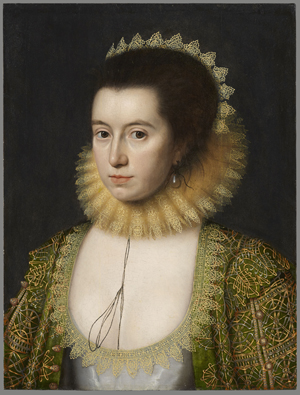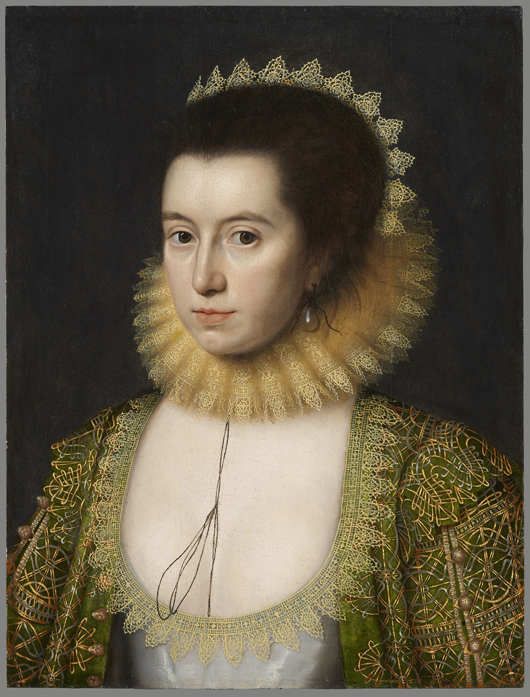
LONDON – The National Portrait Gallery has acquired a rediscovered painted portrait Lady Anne Clifford, a 17th century patron, builder and conservationist. A rare woman fighting a male-dominated establishment, Clifford is now seen as a proto-feminist, determined not to be bullied or coaxed into accepting less than she believed to be her due. At her death she was probably the wealthiest woman in England.
Previously lost, recorded only through literary references, the portrait of Lady Anne Clifford was discovered by Mark Weiss of the Weiss Gallery in a European private collection and sold to the National Portrait Gallery for £275,000 ($446,237). The purchase was funded with £70,000 given by the Art Fund and the remainder from the Gallery’s Portrait Fund and acquisition budget and over £45,000 from private donations.
Lady Anne’s diary entry records that she sat for the artist William Larkin during the summer of 1618, at the age of 28. Larkin produced two portraits, one that stayed at Knole in Kent, and this one, which was sent to her cousin. It is of outstanding quality for a work of this period and is clearly recognizable as Anne by comparison with other portraits and with her own description: “the colour of mine eyes was black like my father’s and the form and aspect of them was quicke and lively like my mother’s. The hair of my head was brown and very thick … with a peak of hair on my forehead, and a dimple in my chin.”
Lady Anne Clifford, Countess of Dorset and later Countess of Pembroke (1590-1676) was well-educated and intelligent; her knowledge and conversational abilities were commented on by John Donne: “She knew well how to discourse of all things, from predestination to slea-silk.”
Her life was dominated by her extended and very public attempts to claim what she believed was rightfully her inheritance from her father, George Clifford, Third Earl of Cumberland, who had left her money, but left his extensive properties to Anne’s uncle. Through archival research, legal disputes and astonishing persistence, she was able to establish the justice of at least part of her claims. Her unhappy marriages to Richard Sackville, Third Earl of Dorset, and subsequently Philip Herbert, Fourth Earl of Pembroke, were both help and hindrance in these disputes.
She eventually inherited most of the disputed estates on the death of her uncle and cousin, and became famous in her latter years for her very extensive building and restoration works on her castles and churches in the north of England. Her patronage also extended to commissioning a substantial number of works of family history, among them three ‘Great Books’ of record (including an autobiography), a book about her father’s voyages, and a book of her mother’s letters. She kept her own diary, parts of which have survived and are important records of early 17th century aristocratic life. She commissioned a large number of portraits of herself, including a huge triptych, now at Abbot Hall in Cumbria, recording her own appearance at different ages, as well as that of various family members.
William Larkin (d. 1619), one of the most prominent and influential artists of the early 17th century, is currently represented in the National Portrait Gallery only by a head-and-shoulders portrait of Frances Howard, Countess of Somerset and a full-length portrait of George Villiers, First Duke of Buckingham. Both appear to be largely studio works, of much lower quality than the present portrait. In particular, comparison of the faces in the three portraits emphasizes the exceptionally subtle and sophisticated modeling in the portrait of Lady Anne.
The National Portrait Gallery currently has one portrait of Lady Anne Clifford, a record of her appearance later in life, which is a copy of a portrait by Sir Peter Lely painted in the 1640s.
Catharine MacLeod, curator of 17th century portraits, National Portrait Gallery, London, says: “It is very exciting to be able to represent such a fascinating and prominent 17th-century woman with such a beautiful portrait. The modeling of the face is particularly refined and subtle, conveying a sense of individuality and personality unusual in English portraiture at this time.”
Lady Anne Clifford by William Larkin will go on display in the gallery from spring 2014.
ADDITIONAL IMAGE OF NOTE



